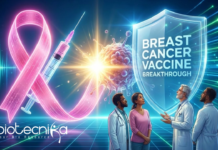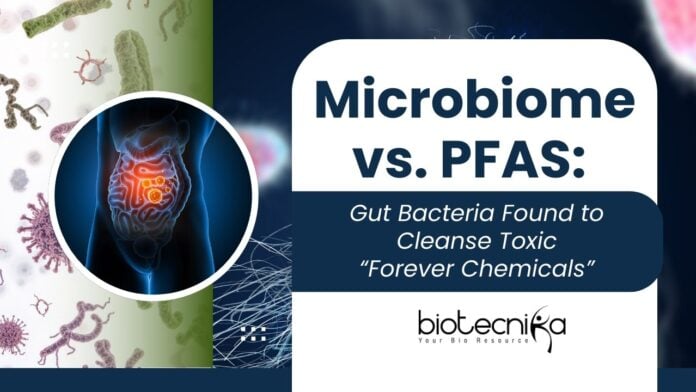Microbiome vs. PFAS: Gut Bacteria Found to Detox “Forever Chemicals”
Gut Microbes: The Unexpected Heroes in the PFAS Crisis
Every time we order a slice of pizza or quickly grab food that is wrapped in grease-resistant packaging, we’re not just indulging in a tasty treat; we may also be exposing ourselves to harmful chemicals. Many food containers, wrappers, and takeaway boxes are coated with PFAS (per- and polyfluoroalkyl substances), commonly known as “forever chemicals.”
These chemicals, as their name implies, have been present in our surroundings for a long time. They are found to be very difficult to break down. Additionally, they will remain in the human body for a longer period of time once they enter!
However, researchers from the MRC Toxicology at the University of Cambridge have identified a specific gut bacterium. This particular bacterium has the capacity to absorb and eliminate toxic chemicals. The fascinating part about this bacterium is that it is already present in our gut microbiome. The results of the research show that they can potentially help us detoxify the PFAS that have entered our bodies.
The study, published in Nature Microbiology, demonstrates that these microbes have a crucial role in the detoxification of PFAS. The study is highly beneficial as it could be a potential treatment procedure to remove toxins without any invasive procedures.
PFAS Absorption by Faecalibacterium prausnitzii and its Friends
Faecalibacterium prausnitzii is one of the most crucial gut bacteria found to detox PFAS. It is a bacterium found in the human gut and has anti-inflammatory properties. This microbe, along with Bacteroides uniformis and 36 other strains, demonstrated an astonishing ability to absorb PFAS compounds during laboratory experiments, sometimes concentrating them up to 50-fold.
The bacteria have a mechanism to absorb these toxins and store them safely in intracellular clusters. And they can perform this function even when the PFAS concentrations are increased to very high levels. They were found to remove 25% to 74% of the toxins, depending on the conditions. This could be one of the most effective strategies for removing toxins and reducing their levels in the human body. And can also be a novel solution for the health issues occurring from PFAS toxins.
Evidence through Petri dishes and Mouse Models:
To prove the findings, the team further investigated and tested in mouse models. Researchers selected a bacterium that has shown the most promising results and inserted it into mouse models. This created a study group that possesses a gut microbiome similar to humans.
The results obtained were astonishing!
The bacteria were able to potentially remove the ingested PFAS from the source. The toxins were flushed out through faeces. These findings suggested that engineered or enhanced gut flora could become a frontline defense against PFAS exposure in humans. This not only replaces tedious and invasive methods, such as blood filtration techniques, but also serves as a potential alternative to medicines that come with numerous side effects.
Cambiotics
Recognizing the potential of the team’s research, Dr. Kiran Patil, as the lead of a research group, co-founded Cambiotics, a biotech company aiming to commercialize PFAS-targeting probiotics.
Founded in early 2024, Cambiotics is among the few discoveries that offer next-generation probiotics containing two of the most potent bacterial strains, belonging to the families Bacteroides and Streptococcus. These are referred to as 46-XY1 and 46-SL1. They appear to intercept PFAS in the gut and prevent their reabsorption, while also acting to excrete them through egestion, with the most tremendous promise.
The team looks to launch the first probiotic product in 2026. The product will be safe and easily accessible to the public.
Why This Matters: A Turning Point in Public Health
PFAS are present in almost all the products that we use in our daily lives. They are widely present in non-stick cookware, cosmetics, firefighting foams, and even drinking water. These chemicals gradually accumulate in our bodies, resulting in severe health consequences.
While traditional removal methods, such as blood plasma exchange, are already available, the treatment method is considered to be expensive. It is also an invasive procedure and practically impossible on a large scale. To overcome these challenges, Cambiotics can offer a more effective approach to toxin removal procedures.
The discovery shows that the gut bacteria found to detox and can safely and naturally eliminate PFAS offers a beacon of hope, especially for at-risk populations and communities affected by water contamination.
After the trials and experiments in the lab levels, the next step will be the human clinical trials. Although the results from mouse models are promising, trials and tests on humans will be a crucial next step. Cambiotics and academic collaborators are working to secure regulatory approval to begin testing the probiotics in human volunteers.
If successful, this innovation could become a cornerstone in environmental and preventive medicine, a biological shield against one of the most persistent toxic threats of our era.
This isn’t just a win for science; this could be a hopeful sign for all of us. It suggests that the human body can combat these toxins with a bit of help from these microbes. As scientists move closer to turning this discovery into real probiotic treatments, we may be looking at a future where protecting our health begins from within.























